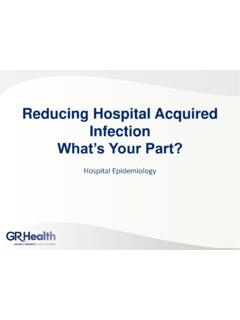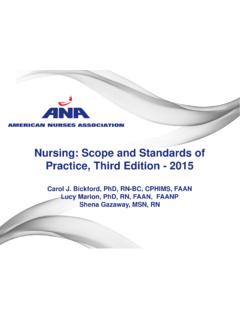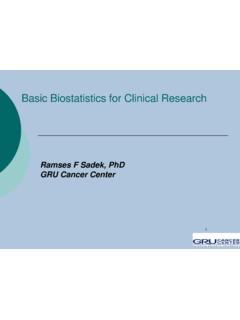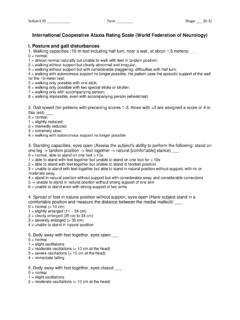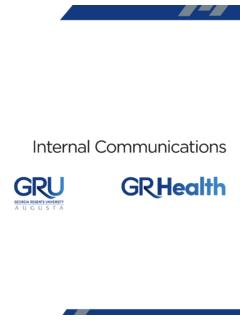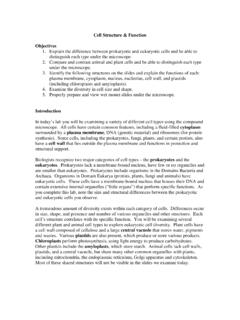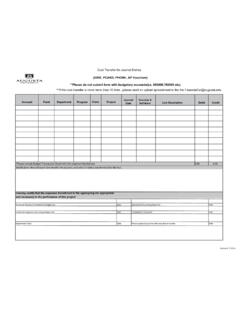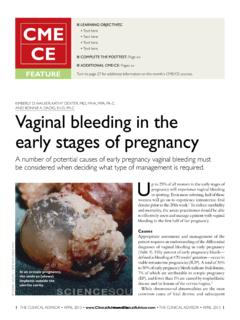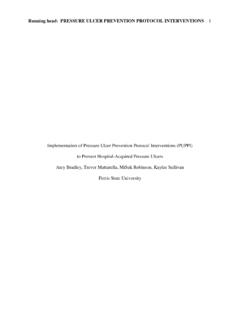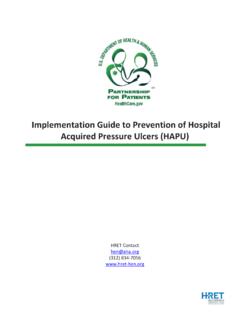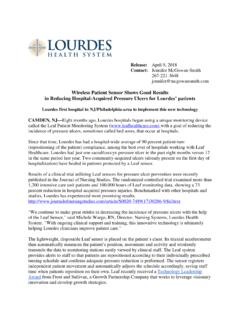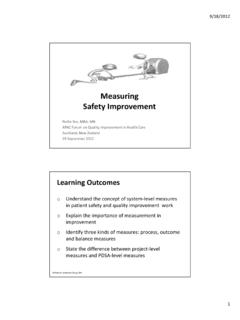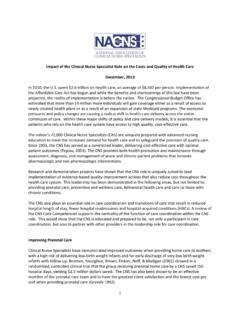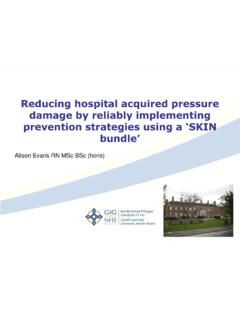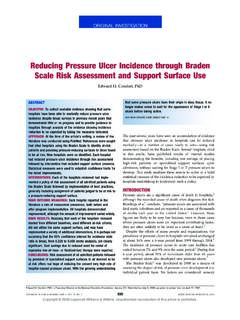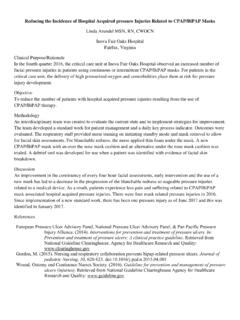Transcription of Reducing Hospital Acquired Infection - augusta.edu
1 Reducing HospitalAcquired Infection What s Your Part? Hospital EpidemiologyExt 1-2224 Objectives Identify prevention strategies for HAI/MDROs and HCW exposure Recall the financial impact to institution for HAI Recognize the abbreviations of the MDROs and select the appropriate transmission based precautions to initiate Describe the order of PPE application and removalHealthcare Acquired Infections (HAI)Healthcare-associated infections (HAIs) infections patients can get while receiving medical treatment in a healthcare facility are a major, yet often preventable, threat to patient safety. Any Infection occurring in the patient because of coming into the Hospital /clinicsConsequences of Hospital Acquired Infections for PatientsJAMA Internal Medicine, Published online Sept.
2 2,2013 Cost hospitals and healthcare institutions more than $ billion each year12 extra Hospital days on an averageStandard Precautions include Practices for: Hand Hygiene PPE Environmental Control Respiratory hygiene/ cough etiquette Sharps Safety Patient resuscitation Textiles and Laundry*Standard precautions are the foundation for preventing transmission of infectious diseases. They apply to all patients and across all health care settings (eg, hospitals, ambulatory surgery centers, free-standing specialty care sites, interventional sites).HCW Risk of ExposureHCWE nvironmental SurfacesOrganismsPatientHealthcare Workers Risk of ExposureBlood borne Pathogens-Occupational exposure to blood and all body substances secretions, excretions (except sweat), regardless of whether it contains visible bloodUsually by: Needle sticks or other sharps injury Mucosal contact (eyes, inside nose and/or mouth) Non-intact skin exposureBlood Borne Pathogen ExposureHealthcare workers most at risk for exposure to:-Hepatitis B (HBV)-Hepatitis C (HCV)-Human Immunodeficiency Virus (HIV)Mechanisms of exposure include.
3 -Contaminated needle sticks or cuts from other sharp instruments-Eye, nose, mouth, or non-intact skin contact with blood or other potentially infectious materialExposure risk is determined by YOUR tasks/duties performed-The Blood borne Pathogen Exposure Control Plan located in the Infection Control ManualEmployee Health and Wellness Handles employee blood borne pathogen exposures. During business hours: Call Employee Health and Wellness to receive packet of forms . After business hours: go to ED. Always follow up with Employee Health and is a vaccine to prevent Hepatitis B (a series of 3 shots). For more information, callOccupational Health Services at Health and Wellness Annual fit testing for N-95 mask Used during Airborne Precaution cases with known or suspected TB (Mycobacterium tuberculosis)Bacteria floats in the air.
4 Transmission from one person to another through air borne working in High Risk Areas ER, Respiratory department, Radiology and Transport team members May be required to receive tuberculosis screeningevery 6 monthsReminder: All employees are tested once a year during your annual employee health and wellness visit. Airborne Precautions are employed. Evaluation is done promptly. Patient is place in negative pressure room or given a surgical mask to wear until negative pressure room is available. Diagnostic measures Complete history Physical exam Chest x-ray 3 sputum specimens collected for acid fast bacilli smear and cultureWhen TB is suspected:Confirmed TB Cases Patients with known or suspected tuberculosis are placed in a private room with negative pressure and the door remains closed at all times.
5 If a room is not available, a portable HEPA machine may be used until a negative pressure room is available. Place HEPA filter machine between the door and the patient. The door must remain closed. Damp towels should be placed at the bottom of the doors to minimize airflow out of the room. If transportation of patient is necessary, the patient wears a surgical mask. When patient is discharged from the room the machine must run for at least 1 hour. TB Control PlanWork Practice Controls TB screening of patients on admission in all settings Airborne Precautions for suspected/known casesEnvironmental Controls/Engineered Controls Negative pressure patient rooms for suspected/known cases Negative pressure rooms for high risk procedures Portable HEPA units if negative pressure unavailable Ultraviolet light in high risk areas Located in the Infection Control ManualThe Foundation of Infection Prevention-2 Types of Precautions Standard Precautions-Foundation of Infection prevention-Component of the blood borne pathogen exposure control plan Transmission
6 Based Precautions-Implemented for known or suspected Infection with the potential to be spread from patient to patientHand HygieneMost common mode of transmission of pathogens is via hands! Clean hands are the single most important factor in preventing the spread of pathogens and antibiotic resistance in healthcare settings. Hand hygiene reduces the incidence of healthcare associated HygieneDoes wearing gloves replace hand hygiene? Wearing gloves does not replace hand hygiene. Studies have found a 15-17% rate of colonization from methicillin-resistant Staphylococcus aureus (MRSA)-positive patients to health care personnel s hands after removal of gloves.
7 According to the Centers for Disease Control and Prevention, more than 700,000 healthcare-associated infections occur in acute care hospitals every year. It is well documented that effective hand hygiene helps reduce the spread of infections. Despite this evidence, Heath Care Providers practice hand hygiene less than half of the times they should. Hand hygiene is widely recognized as the most important measure to prevent the spread of Infection . Despite evidence that improving hand hygiene reduces the risk of Infection and improves patient outcomes, compliance with hand hygiene remains low. Timothy Landers, RN, CNP, PhD, CIC: 2015 APIC Guide to Hand Hygiene Programs for Infection PreventionWhat Is Hand Hygiene?
8 Hand hygiene refers to the act of cleansing hands with water or liquids and includes the use of water, soaps, antiseptics, or other substances, including alcohol-based hand personnel are being held accountable for their hand hygiene practices to prevent transmission of MDROs, and healthcare institutions are facing increasing regulationand hand hygiene mandates while being challenged with economic consequences of failing to meet those Commission Before patient contact and after contact with patient s skin Before donning gloves and after removing gloves When going from dirty to clean tasks/procedures When visibly dirty, contaminated or all must adhere to Hand Hygiene guidelinesWashing with Soap and Water Wet hands with water, apply soap, rub hands together (vigorously rub all surfaces)
9 For 15 seconds Rinse and dry with disposable towel Use towel to turn off faucet Skin Care: Use Hospital -approved lotion to prevent skin breakdown Fingernails: Keep natural nails short with well groomed cuticles. Nail polish must be in good repair. Artificial nails are not to be worn by care givers because of the risk of Infection to staff and patientsAlcohol Based Hand Sanitizer Hospital approved alcohol based hand sanitizer (foam/gel) is an acceptable form of hand hygiene if hands are not visibly dirty. May be used 8-10 times consecutively before soap and water is required. Apply to palm of one hand & Rub hands together covering all surfaces of both hands until dry.
10 ATTENTION: When caring for patients with Clostridium difficile, other spore forming bacteria or norovirus wash hands with soap and water. Do not use alcohol based foam!Hand Hygiene VideoSummary While a hand hygiene program alone cannot absolutely control disease transmission, it remains the cornerstone of all effective prevention programs and the foundation upon which other practices are designed. In this context, hand hygiene continues to offer one of the simplest and most effective solutions to help prevent infections, maximize patient safety, and improve healthcare outcomes across the continuum of care.
